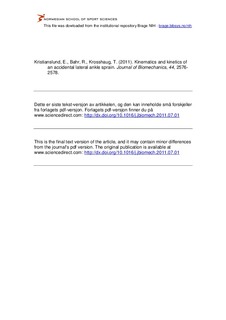| dc.contributor.author | Kristianslund, Eirik | |
| dc.contributor.author | Bahr, Roald | |
| dc.contributor.author | Krosshaug, Tron | |
| dc.date.accessioned | 2013-01-11T14:31:48Z | |
| dc.date.available | 2013-01-11T14:31:48Z | |
| dc.date.issued | 2011 | |
| dc.identifier | Seksjon for idrettsmedisinske fag / Department of Sports Medicine | |
| dc.identifier.citation | Journal of Biomechanics. 2011, 44(14), 2576-2578 | no_NO |
| dc.identifier.issn | 0021-9290 | |
| dc.identifier.uri | http://hdl.handle.net/11250/171098 | |
| dc.description | I Brage finner du siste tekst-versjon av artikkelen, og den kan inneholde ubetydelige forskjeller fra forlagets pdf-versjon. Forlagets pdf-versjon finner du på www.sciencedirect.com: http://dx.doi.org/10.1016/j.jbiomech.2011.07.014 / In Brage you'll find the final text version of the article, and it may contain insignificant differences from the journal's pdf version. The definitive version is available at www.sciencedirect.com: http://dx.doi.org/10.1016/j.jbiomech.2011.07.014 | no_NO |
| dc.description.abstract | Ankle sprains are common during sporting activities and can have serious consequences. Understanding of injury mechanisms is essential to prevent injuries, but only two previous studies have provided detailed descriptions of the kinematics of lateral ankle sprains and measures of kinetics are missing. In the present study a female handball player accidentally sprained her ankle during sidestep cutting in a motion analysis laboratory. Kinematics and kinetics were calculated from 240 Hz recordings with a full-body marker setup. The injury trial was compared with two previous (non-injury) trials. The injury trial showed a sudden increase in inversion and internal rotation that peaked between 130 and 180 ms after initial contact. We observed an attempted unloading of the foot from 80 ms after initial contact. As the inversion and internal rotation progressed, the loads were likely to exceed injury threshold between 130 and 180 ms. There was a considerable amount of dorsiflexion in the injury trial compared to neutral flexion in the control trials, similar to the previously published kinematical descriptions of lateral ankle sprains. The present study also adds valuable kinetic information that improves understanding of the injury mechanism. | no_NO |
| dc.language.iso | eng | no_NO |
| dc.publisher | Elsevier | no_NO |
| dc.subject | ankle | no_NO |
| dc.subject | sprain | no_NO |
| dc.subject | 3D motion analysis | no_NO |
| dc.title | Kinematics and kinetics of an accidental lateral ankle sprain | no_NO |
| dc.type | Journal article | no_NO |
| dc.type | Peer reviewed | no_NO |
| dc.subject.nsi | VDP::Technology: 500 | no_NO |
| dc.source.pagenumber | 2576-2578 | no_NO |
| dc.source.volume | 44 | no_NO |
| dc.source.journal | Journal of Biomechanics | no_NO |
| dc.source.issue | 14 | no_NO |
| dc.identifier.doi | 10.1016/j.jbiomech.2011.07.014 | |
